 The
Medjugorje Fasting Book,
by Wayne Weible, the author who brought so many to the famed
and under-study apparition site now provides an anointed look at a central
message from the Blessed Mother concerning the great, hidden power -- and
requirement -- of fasting. Is it tough to do? Sometimes. Can we approach it
in a way that makes it easier? Yes. He unlocks the door to the purpose of
fasting and offers keys to making it an enduring, transforming part of our
lives!
CLICK HERE The
Medjugorje Fasting Book,
by Wayne Weible, the author who brought so many to the famed
and under-study apparition site now provides an anointed look at a central
message from the Blessed Mother concerning the great, hidden power -- and
requirement -- of fasting. Is it tough to do? Sometimes. Can we approach it
in a way that makes it easier? Yes. He unlocks the door to the purpose of
fasting and offers keys to making it an enduring, transforming part of our
lives!
CLICK HERE
|

__________________________________________________
WHAT'S A REAL 'MIRACULOUS' PHOTO AND WHAT'S NOT IN THE ARRAY OF PICTURES
WITH ORIGINS THAT ARE UNCLEAR?
Does God manifest through
photographs? Pictures? Statues? When does life imitate art, and art
imitate life? Can art come to life?
Years ago, we took two photographs of a
Blessed Mother statue at
Our Lady of Fatima Shrine in Youngstown,
New York, and when they were developed, one showed her as we had seen her (a grayish-white statue and a somewhat gray day) but the second
picture showed a face on the statue that seemed alive (particularly the
eyes) and a bright blue sky as backdrop. It wasn't a matter of a different
angle or setting. It didn't seem like the same
statue nor the same day. We receive photographs from many who have had the
same experience (a statue that seemed to have turned, or smiled, or
frowned, or bent ever so slightly, at poignant moments), and back in the 1990s, hundreds
upon hundreds at more than a dozen
roadside grottos across Ireland claimed something similar: statues of the Blessed Mother, Saint
Joseph, Saint Padre Pio, and Therese the Little Flower that were coming to
"life" before their very eyes, with motion and even
veils that ruffled, that fluttered, in a breeze; at times, many claimed,
ethereal forms -- apparitions -- seemed to come from the lifeless
representations. Hallucination? Mass hysteria? The "silly season" (as the
press called it)? Many are those who have taken
photographs of statues at holy places and watched as the developed
pictures showed the statue's head slightly tilted, or now frowning, or now
smiling, perhaps a difference in color or texture (send
us yours). We are not as quick to dismiss it. Heaven can do
what it wants and can be subtle (never out to convince the skeptics) with
its signs. It was an angel or the Lord coming out of a Crucifix that gave Saint Padre Pio the wounds of stigmata. It was a Crucifix that "spoke" to Saint
Francis at Assisi.
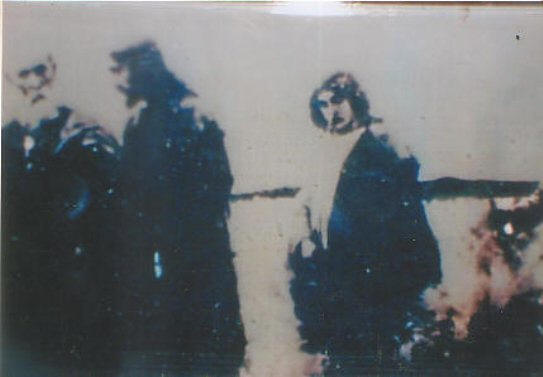
 We
bring this up because of the true curiosity and perhaps phenomenon
of what might be called the "Jesus at the Jordan" photograph
[left] that has
circulated around the internet for years (and in private settings for
perhaps six decades, including at the home of renowned -- and authentic --
mystic Maria Esperanza, who obviously thought it was special). The question: how did this photograph,
which does have a special quality, originate, and how is it
related to a tremendously similar painting by a German artist named
Johannes Raphael Wehle (circa. 1990, right)? The first reaction is
that it is simply a
photograph of the painting -- a remarkable, anointed painting, an inspired
painting, but a painting. Or is it?
We
bring this up because of the true curiosity and perhaps phenomenon
of what might be called the "Jesus at the Jordan" photograph
[left] that has
circulated around the internet for years (and in private settings for
perhaps six decades, including at the home of renowned -- and authentic --
mystic Maria Esperanza, who obviously thought it was special). The question: how did this photograph,
which does have a special quality, originate, and how is it
related to a tremendously similar painting by a German artist named
Johannes Raphael Wehle (circa. 1990, right)? The first reaction is
that it is simply a
photograph of the painting -- a remarkable, anointed painting, an inspired
painting, but a painting. Or is it?
Close-ups show subtle but key
differences (especially in the faces). We have some feedback from viewers
at the end of this article. [See
previous article.] Whether or not in this
instance, the supernatural, it seems, can inflect itself onto a camera as
a picture is taken (although the precise origin of the photo remains a
mystery).
Below to the left, we see an obvious sketching
and below it a painting (this time with Mary holding the Child).
Note how similar they are to the "photographs" (actually, probably
the same photograph) to the right and below that.
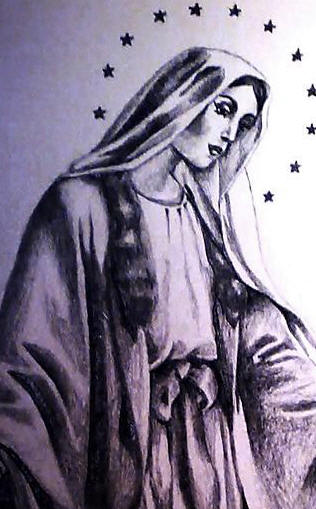
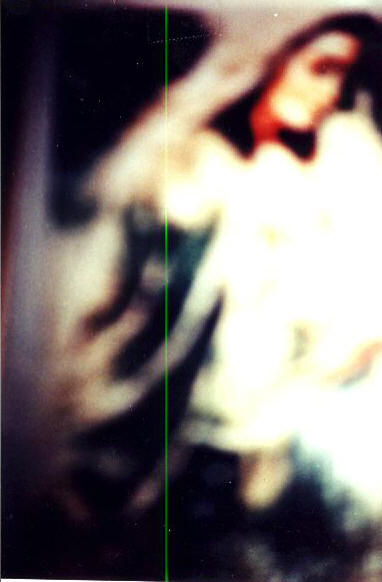 Some
accounts have the ones that look like photographs as originating from Medjugorje,
while another has it from the
Church-approved site of Betania. No one really knows: accounts change and take on a life of their own. For
instance, one story has it that
the painting-like one below the sketching (again, to the
left) occurred at Medjugorje
on Easter 1985 when a French pilgrim took a photo of the sky and the
Virgin Mary and Jesus appeared on the film; as for the more life-like
version, another account states that "during an apparition,
a friend of mine took a picture of the children. Later, when the film was
developed, the Blessed Mother was present hovering over the children. This
photo has been enlarged so you could see the detail of Our Lady. I am told
she was made completely of light which is why you see so much glow in this
photo. It is authentic and was given to me by the woman who took it. It is
said that this photo can heal those who devoutly pray in front of it."
Some
accounts have the ones that look like photographs as originating from Medjugorje,
while another has it from the
Church-approved site of Betania. No one really knows: accounts change and take on a life of their own. For
instance, one story has it that
the painting-like one below the sketching (again, to the
left) occurred at Medjugorje
on Easter 1985 when a French pilgrim took a photo of the sky and the
Virgin Mary and Jesus appeared on the film; as for the more life-like
version, another account states that "during an apparition,
a friend of mine took a picture of the children. Later, when the film was
developed, the Blessed Mother was present hovering over the children. This
photo has been enlarged so you could see the detail of Our Lady. I am told
she was made completely of light which is why you see so much glow in this
photo. It is authentic and was given to me by the woman who took it. It is
said that this photo can heal those who devoutly pray in front of it."
A third version of the origin
goes like this:
"On a day in 1986 a pretty exhausted pilgrim to Medjugorje heard suddenly a call back. He turned
around, but only looked at some distance above the Cross on the mountain.
When after three calls nothing changed, but he impulsively got the idea to
take a photograph. That he did, too. After developing the film, he was not a
little surprised when instead of the Cross of Medjugorje he saw the effigy of
Mother Mary with Child in her arms before him."
Meanwhile the one attributed to Betania comes with an account of it
being taken at the hillside there (after the woman who took
it had a vision of Mary the night before).
The question again: which came first
-- the sketch or the photographic likeness?
It seems obvious that the art was first. But with the photographs, there
are not only the lifelike qualities but in one what seem like other,
smaller images embedded in the
"Blessed Mother's" clothes -- unlike the artwork; surreal (and
not always pleasant) faces.
Do we have to be cautious? Yes: the devil can mimic. And, yes, there are
tales told.
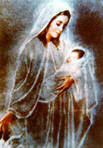
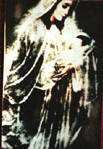
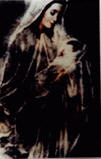 The
same has been true of the Madonna's face (left and right below).
The
same has been true of the Madonna's face (left and right below).
This has appeared
innumerable times, particularly at apparition sites and particularly at
the famous reputed one of Medjugorje (currently under Vatican
investigation).
The one to the right supposedly appeared when
a man developed a print of a photo of the clear horizon and sky at Padre Pio's Shrine an alleged (but rejected) site of apparitions in San Damiano,
Italy. It is more art-like but strikingly similar to the one at the left
which reportedly comes from Medjugorje, where there are various accounts
of it (according to one, an unidentified photographer snapped a picture of the wall
where the alleged apparition was taking place and discovered the picture
when the film was developed.
Is one a rendition of the
other -- somehow. Or are they alike simply because with so many versions of Mary,
there are bound to be similarities?
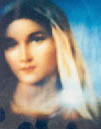
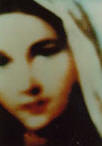 Noted
another account: "I was walking across a
field to a phone to find a tow company that handled motorcycles, when I
saw a white square on the ground. I am in the habit of investigating finds
that seem to call to me, so I
picked up the paper, turned it over, and looked into the face. It
immediately struck me as Mary, though the image is out of focus
and it's not objectively possible for me to tell if this is a picture of a
young woman, of a painting, of a statue, or something else. It certainly
looks lifelike to me, and I chose to guess that this is a living woman. I
suppose an imaging specialist could analyze it and discover whether the
subject was flat or three dimensional. In any case, I felt I'd been
touched, warmed. I have read much about Marian apparitions around the
world throughout history and in present times, and some of the photos
resemble this one. I am not particularly concerned whether or not it's
materialization was miraculous -- it happens to be printed on Kodak paper,
so if it is indeed a miracle, it would make quite an advertisement! I am
simply struck by the image itself and the feeling it inspires."
Noted
another account: "I was walking across a
field to a phone to find a tow company that handled motorcycles, when I
saw a white square on the ground. I am in the habit of investigating finds
that seem to call to me, so I
picked up the paper, turned it over, and looked into the face. It
immediately struck me as Mary, though the image is out of focus
and it's not objectively possible for me to tell if this is a picture of a
young woman, of a painting, of a statue, or something else. It certainly
looks lifelike to me, and I chose to guess that this is a living woman. I
suppose an imaging specialist could analyze it and discover whether the
subject was flat or three dimensional. In any case, I felt I'd been
touched, warmed. I have read much about Marian apparitions around the
world throughout history and in present times, and some of the photos
resemble this one. I am not particularly concerned whether or not it's
materialization was miraculous -- it happens to be printed on Kodak paper,
so if it is indeed a miracle, it would make quite an advertisement! I am
simply struck by the image itself and the feeling it inspires."
Perhaps we should leave it at that.
While on earth, there will always be
enigmas. Definition of "mystery": a religious truth that one can know only
by revelation and cannot fully understand.
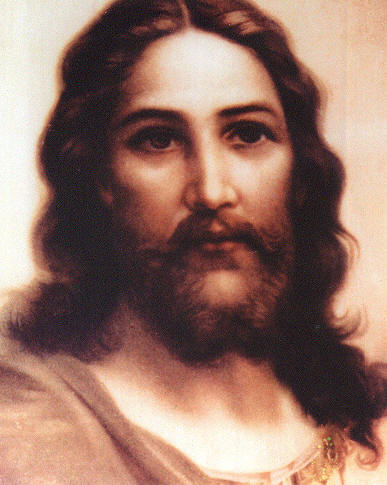
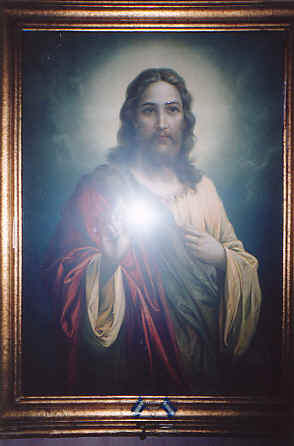 So
too is the beautiful -- and anointed -- picture of Jesus' Face somewhat
of a conundrum. It widely circulated in the early 1990s after a Pennsylvania
woman found it on a roll of film on return, again, from the Holy Land (she did not
recall seeing anything like it in Israel). When she duplicated the
photo, many
claimed to see the image move, change hue, or to otherwise present itself
unusually, with a blessing. Versions of it seemed indeed to have a
mystical quality. It was reproduced thousands of times. Yet, the "photo" (in some
reproductions, truly lifelike, from a Minolta 110 instamatic) was traced
to a painting [right] that hangs at the Grotto of the Milk in Bethlehem
(and also at the Mother Cabrini Shrine in Denver). It was painted by
Austrian artist Hans Zatzka, who went under the pseudonym of H. Zabateri
-- and also painted one of the most famous depictions of the Last Supper.
The likeness of Jesus was used by the Altar Society during the 1940s and
1950s, but the photos from the Holy Land show a
Face with unusual, supra-artistic aspect (and sometimes far more humanlike)
aspects.
So
too is the beautiful -- and anointed -- picture of Jesus' Face somewhat
of a conundrum. It widely circulated in the early 1990s after a Pennsylvania
woman found it on a roll of film on return, again, from the Holy Land (she did not
recall seeing anything like it in Israel). When she duplicated the
photo, many
claimed to see the image move, change hue, or to otherwise present itself
unusually, with a blessing. Versions of it seemed indeed to have a
mystical quality. It was reproduced thousands of times. Yet, the "photo" (in some
reproductions, truly lifelike, from a Minolta 110 instamatic) was traced
to a painting [right] that hangs at the Grotto of the Milk in Bethlehem
(and also at the Mother Cabrini Shrine in Denver). It was painted by
Austrian artist Hans Zatzka, who went under the pseudonym of H. Zabateri
-- and also painted one of the most famous depictions of the Last Supper.
The likeness of Jesus was used by the Altar Society during the 1940s and
1950s, but the photos from the Holy Land show a
Face with unusual, supra-artistic aspect (and sometimes far more humanlike)
aspects.
That brings us back to the "Jesus on
the Jordan" photo (or as the painting is known, "Christ in the Grain Fields"). It might be the most mysterious we have seen. In the age of
"photo-shopping" and other digital legerdemain, it would be far readily
dismissed. But like other "photos," it dates from before the digital
revolution. By one account, it was taken in the 1950s by a woman who had a
companion point a camera over the Jordan; another account says it was shot
in the 1970s at the Western Wall. It is not known what Esperanza, who was
the height of prudence, believed or did not believe, just that she liked
the "photo" (which is enough for us, for she had visions of the
Lord).
And so it goes that we get from them
what we pray with them, as Heaven touches where Heaven wills.
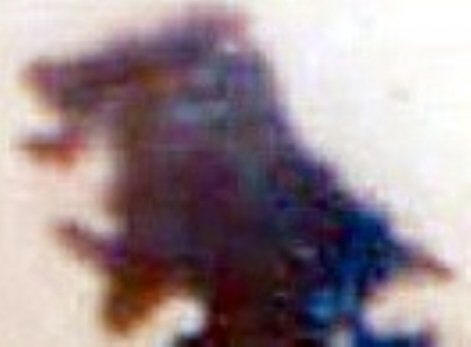
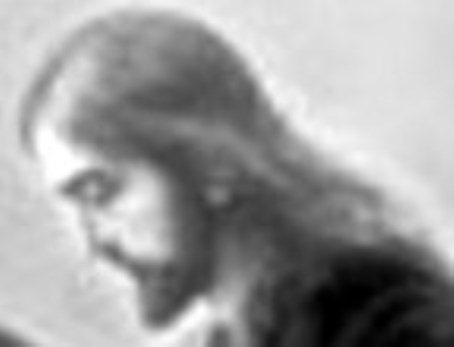 [Feedback
from the mail, Linda Dunlap of Superior, Wisconsin: "I was fascinated by
the articles on the mysterious picture that Maria Esperanza had kept in a
frame . I've been involved in professional photography all of my adult
life, and I couldn't get over the picture having been dated to the
Fifties, when, to me, it looks extremely old, having qualities one would
find in much earlier days of primitive photography. I tried to find out if
the painter of the famous painting, Johannes Raphael Wehle, painted it
during the days of early photography. I found no real helpful information
on him, except that he died in 1936 (so his painting years would, indeed,
fit early photography), so my intellectual guess is that possibly the
story got mixed up as it was passed down, and the painter had actually set
up this scene with models for him to paint from -- artists do it all the
time, and looking at his other paintings, I expect he could have done
that. Time-wise, I can imagine this making perfect sense. But if the story
is more spiritual than that, I'm open to that, too. If it was a moment
caught out of time, wouldn't we love to know? It struck me that the Jesus
figure there does rather resemble the man in the Shroud, doesn't He?
Fascinating in any case. Finding out if the painter had a habit of using
model photographs for his figures would help a lot. And then, look for
any record of who actually shot them, and what their circumstances were.
It's definitely a photograph."
[Feedback
from the mail, Linda Dunlap of Superior, Wisconsin: "I was fascinated by
the articles on the mysterious picture that Maria Esperanza had kept in a
frame . I've been involved in professional photography all of my adult
life, and I couldn't get over the picture having been dated to the
Fifties, when, to me, it looks extremely old, having qualities one would
find in much earlier days of primitive photography. I tried to find out if
the painter of the famous painting, Johannes Raphael Wehle, painted it
during the days of early photography. I found no real helpful information
on him, except that he died in 1936 (so his painting years would, indeed,
fit early photography), so my intellectual guess is that possibly the
story got mixed up as it was passed down, and the painter had actually set
up this scene with models for him to paint from -- artists do it all the
time, and looking at his other paintings, I expect he could have done
that. Time-wise, I can imagine this making perfect sense. But if the story
is more spiritual than that, I'm open to that, too. If it was a moment
caught out of time, wouldn't we love to know? It struck me that the Jesus
figure there does rather resemble the man in the Shroud, doesn't He?
Fascinating in any case. Finding out if the painter had a habit of using
model photographs for his figures would help a lot. And then, look for
any record of who actually shot them, and what their circumstances were.
It's definitely a photograph."
Noted another viewer: "After reading the article
regarding the analysis of the miraculous photo I found
this and thought it was quite
interesting; you can see the marks of the crown of thorns on Christ's
Head in the photo, and not in the paintings, quite amazing!"
"My take on all this is the painter was
divinely inspired to paint 'Christ in the Wheat Fields' and Maria
Esperanza recognized this.," wrote Joan Tedesco of Windermere, Florida.
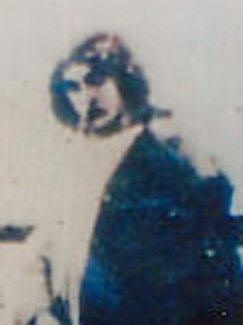
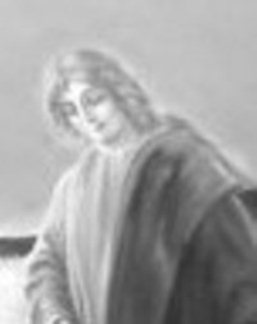 From
Joe Spadaford: "I have worked in the Christian art world for years
now. The gentleman whose points are very accurate about the photo/painting
need to be applauded [see
article]. I had for years believed this
perhaps was a miracle photo...heck I had it as a screen saver for a long
time. Until I saw the painting years later. Now while I agree with all
the character-posing points of view and the difference in style to make
one look like a photo and one like painting; I feel it is very easily
explained. When this painting was painted it was very very common to take
photos (as it still is today) as a reference for a painting. You tell
your models to do simple things like move you head, hand, etc. to get the
pose just right. I do it, Norman Rockwell did, before the camera was even
around DaVinci did with a tool called the camera obscura. You even
take a little from one photo and combine it with another. This is
illustration 101 stuff, and totally explains the differences in painting
to photo. The artist painted from the photo he took. This is also
relevant in the look of the photo itself. Look at what a photo in
1955 would look like versus on from the late 1890's as the picture must
have been taken before the painting was complete. The one from the 1890s
looks exactly like the quality of the photo taken of this 'anointed' photo
that is being examined. Note the wear and tear fading on the edges, the
exposure, and overall lack of clear focus. This is why the artist had to
take liberties and you get that painted/ invented look. As we still do
today. Next we look at a photo taken by a black and white camera from
1955. The edges and exposure are more clear and offer up a much more
realistic image. The artist would have used all that stuff to make a
clear picture because you choose models that best look like what you want
to paint. As for time of day changes, it's simple: these kind of
photo-shoots, especially in the late 1890s, took a lot of time. The
camera needed time to adjust for focus and the actors held the poses. It
is my humble opinion as a professional working artist and photographer
highly skilled in Photoshop that we are looking at the artist's reference
for his painting. And a very nice painting it is. If you want real look at
the Shroud: That cannot be explained, that is as real it can come."
From
Joe Spadaford: "I have worked in the Christian art world for years
now. The gentleman whose points are very accurate about the photo/painting
need to be applauded [see
article]. I had for years believed this
perhaps was a miracle photo...heck I had it as a screen saver for a long
time. Until I saw the painting years later. Now while I agree with all
the character-posing points of view and the difference in style to make
one look like a photo and one like painting; I feel it is very easily
explained. When this painting was painted it was very very common to take
photos (as it still is today) as a reference for a painting. You tell
your models to do simple things like move you head, hand, etc. to get the
pose just right. I do it, Norman Rockwell did, before the camera was even
around DaVinci did with a tool called the camera obscura. You even
take a little from one photo and combine it with another. This is
illustration 101 stuff, and totally explains the differences in painting
to photo. The artist painted from the photo he took. This is also
relevant in the look of the photo itself. Look at what a photo in
1955 would look like versus on from the late 1890's as the picture must
have been taken before the painting was complete. The one from the 1890s
looks exactly like the quality of the photo taken of this 'anointed' photo
that is being examined. Note the wear and tear fading on the edges, the
exposure, and overall lack of clear focus. This is why the artist had to
take liberties and you get that painted/ invented look. As we still do
today. Next we look at a photo taken by a black and white camera from
1955. The edges and exposure are more clear and offer up a much more
realistic image. The artist would have used all that stuff to make a
clear picture because you choose models that best look like what you want
to paint. As for time of day changes, it's simple: these kind of
photo-shoots, especially in the late 1890s, took a lot of time. The
camera needed time to adjust for focus and the actors held the poses. It
is my humble opinion as a professional working artist and photographer
highly skilled in Photoshop that we are looking at the artist's reference
for his painting. And a very nice painting it is. If you want real look at
the Shroud: That cannot be explained, that is as real it can come."
Differed Robert Kauffmann of Cinnaminson,
New Jersey: "A brief observation about the allegedly miraculous photo
versus the painting by Wehle: It may be that the artist received in his
minds eye the same image by the same Divine Illumination that produced the
50's/70's photograph."
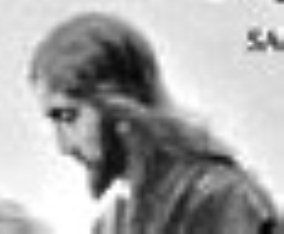
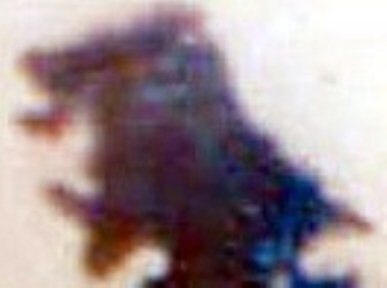 Asks
Richard Mackin, Jr. Maine: "There's so much contemporary info available
about miraculous images etal and near-death experiences which seem
to inevitably produce a book about someone's personal near death
experience: it is interesting but sometimes tedious/ what else is new.
However, with the photo of the Jordan River showing Jesus in comparison
with a painting of similar image it is necessary to ask in this age of
computer technology sophistication: cannot a computer analysis determine
an actual photo of real persons from a painting? Is it an actual photo of
Jesus or a manipulated image? Are you familiar with the Christ In the
Clouds newspaper published image (WWll 1940's)? It looks real but the
report is that it was manipulated. Info is available on the internet.
Photo software is remarkable at altering a poor photo image. Sincerely,
it would be something though if the photo image were an actual photo
of Jesus Himself. It has been two thousand years since He was last on
earth in Person. Time for contemporary mankind to witness The Real Deal."
Asks
Richard Mackin, Jr. Maine: "There's so much contemporary info available
about miraculous images etal and near-death experiences which seem
to inevitably produce a book about someone's personal near death
experience: it is interesting but sometimes tedious/ what else is new.
However, with the photo of the Jordan River showing Jesus in comparison
with a painting of similar image it is necessary to ask in this age of
computer technology sophistication: cannot a computer analysis determine
an actual photo of real persons from a painting? Is it an actual photo of
Jesus or a manipulated image? Are you familiar with the Christ In the
Clouds newspaper published image (WWll 1940's)? It looks real but the
report is that it was manipulated. Info is available on the internet.
Photo software is remarkable at altering a poor photo image. Sincerely,
it would be something though if the photo image were an actual photo
of Jesus Himself. It has been two thousand years since He was last on
earth in Person. Time for contemporary mankind to witness The Real Deal."
Lastly, from a viewer named Melina: "While the paintings are wonderful, the photograph seems to capture a
seriousness on the faces of the Lord and His companions. There is a
look there which is missing on the paintings.
And the paintings are witnesses for the photograph not the other way
around; by the witness of two or three a thing is established (Deuteronomy
19:15)."
[resources:
Michael
Brown Minneapolis retreat, November 3 and
pilgrimage, Medjugorje, May-June]
[Print
article]
E-mail this
link directly
Spirit Daily on Twitter
Facebook

Return
to home page www.spiritdaily.com
 The
Medjugorje Fasting Book,
by Wayne Weible, the author who brought so many to the famed
and under-study apparition site now provides an anointed look at a central
message from the Blessed Mother concerning the great, hidden power -- and
requirement -- of fasting. Is it tough to do? Sometimes. Can we approach it
in a way that makes it easier? Yes. He unlocks the door to the purpose of
fasting and offers keys to making it an enduring, transforming part of our
lives!
CLICK HERE
The
Medjugorje Fasting Book,
by Wayne Weible, the author who brought so many to the famed
and under-study apparition site now provides an anointed look at a central
message from the Blessed Mother concerning the great, hidden power -- and
requirement -- of fasting. Is it tough to do? Sometimes. Can we approach it
in a way that makes it easier? Yes. He unlocks the door to the purpose of
fasting and offers keys to making it an enduring, transforming part of our
lives!
CLICK HERE
 We
bring this up because of the true curiosity and perhaps phenomenon
of what might be called the "Jesus at the Jordan" photograph
[left] that has
circulated around the internet for years (and in private settings for
perhaps six decades, including at the home of renowned -- and authentic --
mystic Maria Esperanza, who obviously thought it was special). The question: how did this photograph,
which does have a special quality, originate, and how is it
related to a tremendously similar painting by a German artist named
Johannes Raphael Wehle (circa. 1990, right)? The first reaction is
that it is simply a
photograph of the painting -- a remarkable, anointed painting, an inspired
painting, but a painting. Or is it?
We
bring this up because of the true curiosity and perhaps phenomenon
of what might be called the "Jesus at the Jordan" photograph
[left] that has
circulated around the internet for years (and in private settings for
perhaps six decades, including at the home of renowned -- and authentic --
mystic Maria Esperanza, who obviously thought it was special). The question: how did this photograph,
which does have a special quality, originate, and how is it
related to a tremendously similar painting by a German artist named
Johannes Raphael Wehle (circa. 1990, right)? The first reaction is
that it is simply a
photograph of the painting -- a remarkable, anointed painting, an inspired
painting, but a painting. Or is it? 



 The
same has been true of the Madonna's face (left and right below).
The
same has been true of the Madonna's face (left and right below). 
 Noted
another account: "I was walking across a
field to a phone to find a tow company that handled motorcycles, when I
saw a white square on the ground. I am in the habit of investigating finds
that seem to call to me, so I
picked up the paper, turned it over, and looked into the face. It
immediately struck me as Mary, though the image is out of focus
and it's not objectively possible for me to tell if this is a picture of a
young woman, of a painting, of a statue, or something else. It certainly
looks lifelike to me, and I chose to guess that this is a living woman. I
suppose an imaging specialist could analyze it and discover whether the
subject was flat or three dimensional. In any case, I felt I'd been
touched, warmed. I have read much about Marian apparitions around the
world throughout history and in present times, and some of the photos
resemble this one. I am not particularly concerned whether or not it's
materialization was miraculous -- it happens to be printed on Kodak paper,
so if it is indeed a miracle, it would make quite an advertisement! I am
simply struck by the image itself and the feeling it inspires."
Noted
another account: "I was walking across a
field to a phone to find a tow company that handled motorcycles, when I
saw a white square on the ground. I am in the habit of investigating finds
that seem to call to me, so I
picked up the paper, turned it over, and looked into the face. It
immediately struck me as Mary, though the image is out of focus
and it's not objectively possible for me to tell if this is a picture of a
young woman, of a painting, of a statue, or something else. It certainly
looks lifelike to me, and I chose to guess that this is a living woman. I
suppose an imaging specialist could analyze it and discover whether the
subject was flat or three dimensional. In any case, I felt I'd been
touched, warmed. I have read much about Marian apparitions around the
world throughout history and in present times, and some of the photos
resemble this one. I am not particularly concerned whether or not it's
materialization was miraculous -- it happens to be printed on Kodak paper,
so if it is indeed a miracle, it would make quite an advertisement! I am
simply struck by the image itself and the feeling it inspires."
 So
too is the beautiful -- and anointed -- picture of Jesus' Face somewhat
of a conundrum. It widely circulated in the early 1990s after a Pennsylvania
woman found it on a roll of film on return, again, from the Holy Land (she did not
recall seeing anything like it in Israel). When she duplicated the
photo, many
claimed to see the image move, change hue, or to otherwise present itself
unusually, with a blessing. Versions of it seemed indeed to have a
mystical quality. It was reproduced thousands of times. Yet, the "photo" (in some
reproductions, truly lifelike, from a Minolta 110 instamatic) was traced
to a painting [right] that hangs at the Grotto of the Milk in Bethlehem
(and also at the Mother Cabrini Shrine in Denver). It was painted by
Austrian artist Hans Zatzka, who went under the pseudonym of H. Zabateri
-- and also painted one of the most famous depictions of the Last Supper.
The likeness of Jesus was used by the Altar Society during the 1940s and
1950s, but the photos from the Holy Land show a
Face with unusual, supra-artistic aspect (and sometimes far more humanlike)
aspects.
So
too is the beautiful -- and anointed -- picture of Jesus' Face somewhat
of a conundrum. It widely circulated in the early 1990s after a Pennsylvania
woman found it on a roll of film on return, again, from the Holy Land (she did not
recall seeing anything like it in Israel). When she duplicated the
photo, many
claimed to see the image move, change hue, or to otherwise present itself
unusually, with a blessing. Versions of it seemed indeed to have a
mystical quality. It was reproduced thousands of times. Yet, the "photo" (in some
reproductions, truly lifelike, from a Minolta 110 instamatic) was traced
to a painting [right] that hangs at the Grotto of the Milk in Bethlehem
(and also at the Mother Cabrini Shrine in Denver). It was painted by
Austrian artist Hans Zatzka, who went under the pseudonym of H. Zabateri
-- and also painted one of the most famous depictions of the Last Supper.
The likeness of Jesus was used by the Altar Society during the 1940s and
1950s, but the photos from the Holy Land show a
Face with unusual, supra-artistic aspect (and sometimes far more humanlike)
aspects.
 [Feedback
from the mail, Linda Dunlap of Superior, Wisconsin: "I was fascinated by
the articles on the mysterious picture that Maria Esperanza had kept in a
frame . I've been involved in professional photography all of my adult
life, and I couldn't get over the picture having been dated to the
Fifties, when, to me, it looks extremely old, having qualities one would
find in much earlier days of primitive photography. I tried to find out if
the painter of the famous painting, Johannes Raphael Wehle, painted it
during the days of early photography. I found no real helpful information
on him, except that he died in 1936 (so his painting years would, indeed,
fit early photography), so my intellectual guess is that possibly the
story got mixed up as it was passed down, and the painter had actually set
up this scene with models for him to paint from -- artists do it all the
time, and looking at his other paintings, I expect he could have done
that. Time-wise, I can imagine this making perfect sense. But if the story
is more spiritual than that, I'm open to that, too. If it was a moment
caught out of time, wouldn't we love to know? It struck me that the Jesus
figure there does rather resemble the man in the Shroud, doesn't He?
Fascinating in any case. Finding out if the painter had a habit of using
model photographs for his figures would help a lot. And then, look for
any record of who actually shot them, and what their circumstances were.
It's definitely a photograph."
[Feedback
from the mail, Linda Dunlap of Superior, Wisconsin: "I was fascinated by
the articles on the mysterious picture that Maria Esperanza had kept in a
frame . I've been involved in professional photography all of my adult
life, and I couldn't get over the picture having been dated to the
Fifties, when, to me, it looks extremely old, having qualities one would
find in much earlier days of primitive photography. I tried to find out if
the painter of the famous painting, Johannes Raphael Wehle, painted it
during the days of early photography. I found no real helpful information
on him, except that he died in 1936 (so his painting years would, indeed,
fit early photography), so my intellectual guess is that possibly the
story got mixed up as it was passed down, and the painter had actually set
up this scene with models for him to paint from -- artists do it all the
time, and looking at his other paintings, I expect he could have done
that. Time-wise, I can imagine this making perfect sense. But if the story
is more spiritual than that, I'm open to that, too. If it was a moment
caught out of time, wouldn't we love to know? It struck me that the Jesus
figure there does rather resemble the man in the Shroud, doesn't He?
Fascinating in any case. Finding out if the painter had a habit of using
model photographs for his figures would help a lot. And then, look for
any record of who actually shot them, and what their circumstances were.
It's definitely a photograph." 
 From
Joe Spadaford: "I have worked in the Christian art world for years
now. The gentleman whose points are very accurate about the photo/painting
need to be applauded [see
From
Joe Spadaford: "I have worked in the Christian art world for years
now. The gentleman whose points are very accurate about the photo/painting
need to be applauded [see 
 Asks
Richard Mackin, Jr. Maine: "There's so much contemporary info available
about miraculous images etal and near-death experiences which seem
to inevitably produce a book about someone's personal near death
experience: it is interesting but sometimes tedious/ what else is new.
However, with the photo of the Jordan River showing Jesus in comparison
with a painting of similar image it is necessary to ask in this age of
computer technology sophistication: cannot a computer analysis determine
an actual photo of real persons from a painting? Is it an actual photo of
Jesus or a manipulated image? Are you familiar with the Christ In the
Clouds newspaper published image (WWll 1940's)? It looks real but the
report is that it was manipulated. Info is available on the internet.
Photo software is remarkable at altering a poor photo image. Sincerely,
it would be something though if the photo image were an actual photo
of Jesus Himself. It has been two thousand years since He was last on
earth in Person. Time for contemporary mankind to witness The Real Deal."
Asks
Richard Mackin, Jr. Maine: "There's so much contemporary info available
about miraculous images etal and near-death experiences which seem
to inevitably produce a book about someone's personal near death
experience: it is interesting but sometimes tedious/ what else is new.
However, with the photo of the Jordan River showing Jesus in comparison
with a painting of similar image it is necessary to ask in this age of
computer technology sophistication: cannot a computer analysis determine
an actual photo of real persons from a painting? Is it an actual photo of
Jesus or a manipulated image? Are you familiar with the Christ In the
Clouds newspaper published image (WWll 1940's)? It looks real but the
report is that it was manipulated. Info is available on the internet.
Photo software is remarkable at altering a poor photo image. Sincerely,
it would be something though if the photo image were an actual photo
of Jesus Himself. It has been two thousand years since He was last on
earth in Person. Time for contemporary mankind to witness The Real Deal."